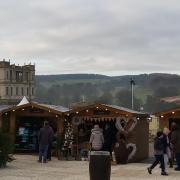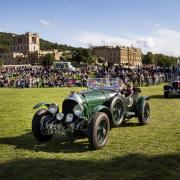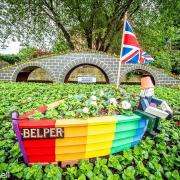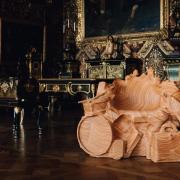Major Thomas Avalon Harris was a character ‘of the old school’ and a keen archaeologist of local prehistoric sites in the 1920s and ‘30s

The Reader’s Digest used to include a regular article describing ‘the most unforgettable person’ various writers had ever met. Archaeologically speaking, my accolade would go to Major Thomas Avalon Harris of Ashford-in-the-Water, who I first met in 1961 when he was in his seventies, and who I found to be a most remarkable character, an Englishman of the old school, vaguely eccentric and a veritable fountain of knowledge on Derbyshire’s prehistoric past. In the early 1960s I had developed an interest in the archaeology of my native county, with particular reference to burial mounds, and their exploration by the 19th century squire Thomas Bateman. I had met Percy Heathcote who had dug extensively on Stanton Moor, and he told me of Major Harris who had been active in the Peak for over 40 years. I set out to meet him after finding out that he was working in Taddington Dale, and that when on site he always parked his old black Rover in a lay-by near his dig.
The Major proved to be a short, slightly-built and balding figure, possessed like so many small men with tremendous enthusiasm and energy. He walked stiffly with a stick, a legacy of an old hip injury, but it never prevented him from climbing onto the roof of his house to make repairs to the slates! When I told him of my quest he invited me to his home at ‘Parkfield’ where I later spent many convivial evenings. On that first visit he showed me one of the lead tablets Bateman left in his barrows to record his presence. He had found it in a mound near Monsal Dale and I enthused at seeing such a rare item. A few days later he sent me a letter in which the tablet was enclosed as a gift. He was always generous, and I still have several artefacts he subsequently passed on to me.
The visit was the start of a friendship which ended only with his death. Harris was an excellent raconteur, and as well as passing on much information on the archaeology of the locality, he was loquacious in regaling me with other episodes in his long life, from motoring in Europe before the First World War to the wars themselves. He was born in Dorset in the 1880s and his archaeological enthusiasms were probably fired when, at a young age, he accompanied his father with Edward Cunnington, one of the great dynasty of Wessex antiquaries, in some of his final barrow-digs. He studied at Cambridge and served in France as a front-line communications officer. After his marriage he brought his young family to Derbyshire in the early 1920s, where he calculated that a pension, plus family bequests and investments would allow him the leisure to pursue his interests into the remote past. Apart from service in World War Two, he pursued these interests for the rest of his life.
Between the wars Harris ranged far and wide across the Peak, finding and exploring caves and locating barrows, hut circles and other prehistoric sites, a number of which he later pointed out to me. On one occasion I took him on a trip in my ancient Land Rover and he showed obvious enjoyment in returning to places long embedded in his memory. In the 1920s and ‘30s there were few professional archaeologists in England, but a number of amateurs of varying skill and ability. In Derbyshire these included individuals who excavated more or less carefully and published their discoveries, such as William Storrs Fox, Percy Heathcote and Leslie Armstrong (despite the last’s proclivity to occasionally fake evidence). Major Harris found much but published little, and was reasonably sane when contrasted with out-and-out crackpots like his contemporary Captain Grainger who saw evidence of primitive pseudo-religious symbolism in natural landscape features and concocted weird theories therefrom.

When I first met Harris I realised that an important task was to get him to speak about his excavation work and try to record it for posterity. Unfortunately he was, like a Dorset antiquary before him (and I quote) ‘not given to taking notes... had he paid careful attention in recording the particulars of his researches... we might now have been in possession of facts most useful to the antiquary.’ I was able to elicit details of several of his digs, at least one of which was of national archaeological importance, but others were simply recalled en passant, and I also found out that he appeared to have preserved scant material. When his collection passed to Sheffield Museum after his death, I found little in the way of notes, plans or sections of his sites. He did lend me negatives of his more productive digs, and these form an essential part of his rather meagre archive.
The Major’s first Derbyshire excavation was on an Early Bronze Age cairn on Fin Cop, which he opened in 1923-4, and which, for all its importance, is recorded only in that august organ, the High Peak News. According to Harris’s account, a primary crouched skeleton in a rock grave was surrounded by seven other inhumations, some with food-vessel sherds. He recorded 23 further skeletons, including 18 infants, plus an inverted urn cremation on the west side, above a burial with a bowl-shaped food-vessel. The pottery is now in Sheffield Museum, but where the bones went is anyone’s guess. It is an abiding pity that no plans, sections, photographs or anything else survives of this singular burial mound. Later in 1924 he commenced work on a ruinous Neolithic horned long cairn at Brushfield, but long-term stone robbing had removed any finds, and made it difficult to interpret, though the remains of a slab-built chamber were once visible.
In 1926 Harris dug a small cairn in Shacklow Wood which produced a primary bucket-shaped pot decorated with cord maggots, and two subsequent child skeletons with a crude beaker. Despite promises, I was never able to view these most interesting pots, and their whereabouts are now unknown. He was occasionally involved in local operations led by other archaeologists. In 1925 a quarry at the south-west end of Stanton Moor was being extended, and removal of the soft upper sandstone beds led to the discovery of three Bronze Age urns. The following year operations at the same spot led to the finding of two more, and Storrs Fox was asked by the estate agent to conduct a thorough search of the area. Unfortunately the quarry owner opposed the loss of time and finance that this would entail. The resulting compromise left no time for a plan of the work, and a small band of voluntary workers cleared the site in three and a half days in September, it being ‘inevitable that the work should be carried out more hastily and roughly than was desirable.’ Seven complete urns, plus three miniature cups and other pottery fragments were unearthed from this flat cremation cemetery, but no other relics were found. Harris, who was one of the volunteers, gained special mention, Storrs Fox relating that he ‘not only worked indefatiguably, but also undertook the preliminary cleaning of the vessels’ which were duly passed on to Derby Museum.
Harris was always fond of telling me he had a knack of sniffing out burials, and he certainly found some in unlikely places. In 1932 he carried out a speculative dig in a rock fissure in Demon’s Dale where he located a series of Early Bronze Age skeletons buried in layers. Six feet down was a tightly-crouched male which he believed had a fine leaf-shaped flint dagger placed with him. He told me he was certain he had been seen at work, and returned the next day to find some disturbance at the site. Soon afterwards the owner of a roadside cafe in nearby Taddington Dale put the artefact on display, and later more-or-less confessed to Harris that he had taken it from the cleft. Again, this fine weapon remains lost. Below this burial, at a depth of 11 feet, were two overlapping crouched skeletons, one minus the skull, whilst two feet lower was a very fragmentary and partly mineralised set of incomplete bones.

The major’s most important dig, which was at least recorded in print, was at Calling Low Dale, a southern offshoot of Lathkill Dale, where he felt there was a rock shelter under a talus slope below an overhanging limestone cliff. In 1937, working with Armstrong, who was a close friend, he uncovered two cist burials lying close together, built up against the rock wall and covered with rubble. The western one had a crouched skeleton lying in front of it, and a further contracted female skeleton inside, both showing the dolichocephalic (long-headed) skulls characteristic of the Neolithic period. The female skeleton was by no means a straightforward interment, and if Harris’s photograph of it is trustworthy the cist contained a bundle of human ribs, and at least two child mandibles, whilst the woman’s sacrum was propped up against the rear wall of the cist. In the vicinity were several crouched child inhumations, one laid alongside the east wall of the cist.
The eastern cist was even more interesting than its companion. It was filled with fine soil which contained a mass of disarticulated human bones, the majority representing one person, with parts of three or four others. There were no crania, but sherds of two pots and a petit tranchet flint arrowhead. The pots were round-based Neolithic bowls of Mortlake type ware. One was capable of reconstruction and this survives, together with the arrowhead. Its all-over incised decoration was fashioned using bones from the Sandpiper. The interments are rare examples of late Neolithic funeral ritual when the old traditions of collective burial were being gradually replaced by more individual immolation, brought about by contact with more advanced communities from Europe who brought new customs and ideas, as well as metals and fresh pottery styles, including early beakers.
The collective cist seems to have had priority, whilst the individual skeletons appear to represent the slightly later newly emerging traditions. Whether the bones in the eastern cist, later published by Stuart Piggott, are correctly drawn in his plan is conjectural, as the only photograph of the cist was taken after it was cleared. Again, one must regret the lack of a comprehensive report on the excavation, and apart from the pot and arrowhead, only the two skulls from the western burial were preserved.
Twenty-nine years later I found the next stage in the local prehistoric burial process, in the Bee Low round cairn some half-mile south-east of Calling Low Dale. The primary interment here was another collective cist containing not a Mortlake bowl but a very early beaker. In a previous opening in 1851 the local antiquary Thomas Bateman had found a limestone cist containing the stacked-up bones of a completely disarticulated old man, perhaps another hark-back to the old traditions.

As well as his work in Derbyshire, Harris was also active in other parts of England, and abroad. He accompanied Armstrong to Rhodesia in 1929 on a three-month dig at the Bambata Caves, and was with him at the Grimes Graves flint mines in Norfolk in 1939. A year earlier he assisted with Bersu’s operations at the Little Woodbury Iron Age farm in Wiltshire. He told me he was put in charge of cleaning up the chalk surfaces of the many trenches cut across the site. On one occasion he came face to face with Kathleen Kenyon, who carried a fearsome array of tools in the belt of her overalls. The Major instinctively flung up his arms in surrender, but the great woman was reportedly not amused!
When I first met the Major, his days of discovery were long over, and he had become slightly batty, convinced that a location he was working at in Taddington Dale held an important prehistoric grave, but which produced absolutely nothing to my eye but natural waterworn limestone hollows. In 1973 his wife of over 50 years, Bessie, a most friendly lady, died and he soon followed her. For a long time I missed him deeply for his knowledge, hospitality and his sheer personality. Archaeologically he had many faults, but my fortuitous friendship with him did allow me to rescue the details of many of his diggings, and helped preserve his memory, like some archaeological Boswell to his Dr Johnson.



























